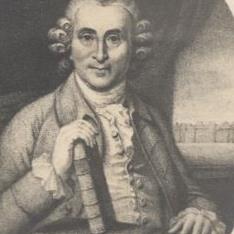
Biography
James Lind was born in Edinburgh on 4 October 1716 to James Lind, a merchant, and Margaret Smelholme, a member of an Edinburgh medical family. Lind attended grammar school in Edinburgh and in 1731 was apprenticed to George Langlands, an Edinburgh surgeon. In 1734, Lind attended a course on anatomy given by Alexander Monro primus at Edinburgh University. In 1738, with no formal qualifications, Lind became a royal naval surgeon, serving until 1748. This period at sea influenced Lind’s lifework – the welfare of seamen and the nature and treatment of scurvy.
In 1748, Lind graduated MD from Edinburgh with a thesis on venereal disease. For the next ten years, he likely engaged in private practice in Edinburgh while participating in the professional medical life of the city. He became a fellow of the Royal College of Physicians of Edinburgh in 1750 and became its treasurer in 1756. He was also a member of the Philosophical and Medical Society of Edinburgh. In 1758, Lind was appointed physician in charge at Haslar Royal Naval Hospital, a position he held until 1783.
Lind’s most famous work, A Treatise of the Scurvy, lays out his theories on the causes and cures of the disease. He attributed diet and the digestive system as key components of the cause of scurvy, noting that it was a disease of faulty digestion and excretion. His proposed cure involves a warm and dry atmosphere and a readily digestibly diet, especially for ships at sea. Lind conducted experiments while he was a surgeon in 1747 on seamen with scurvy, breaking the men up into groups with different potential remedies. The men who were prescribed lemons and oranges quickly recovered, whereas the others did not. Since Lind did not have an understanding of what would today be referred to as a vitamin deficiency, his experiments were not as conclusive as they are to the modern reader. Lind’s solution to scurvy on ships, therefore, included a wide-ranging set of recommendations for the amelioration of life at sea.
Lind also advocated for the health of seamen and promoted better hygiene on board ships and for a more humane treatment of seamen. Lind promoted seamen taking baths, that ships be fumigated and ventilated, and that seamen be issued uniforms. He also advocated for improved diets with regular supplies of fresh vegetables. Lind’s third book was, like his first two, prescriptive. He recommended that settlements should be built as far away as possible from low-lying swampy regions. Here he tackles environmental and public health concerns. This book, as with his first two, was practical and clearly written. His books were widely translated and quoted, despite the sometimes tentative nature of his writing. Lind’s influence on the health and welfare of seamen is indisputable. He died on 18 July 1794 at Gosport.
Notable Achievements
Lind was elected fellow of the Royal College of Physicians of Edinburgh in 1750.
He was elected fellow of the Royal Society of Edinburgh in 1783.
Key Publications
- A Treatise of the Scurvy (1753)
- An Essay on the Most Effectual Means of Preserving the Health of Seamen in the Royal Navy (1757)
- An Essay on Diseases Incidental to Europeans in Hot Climates (1768)



